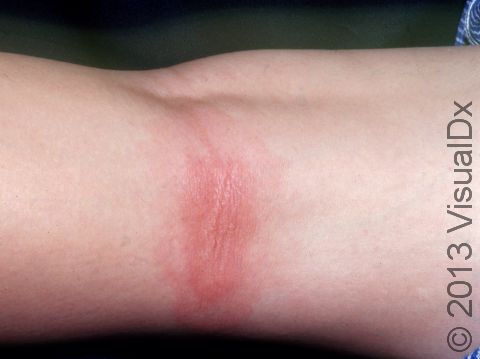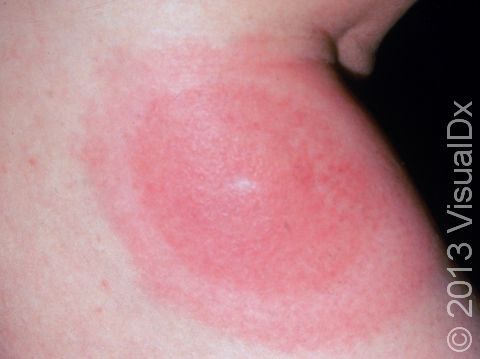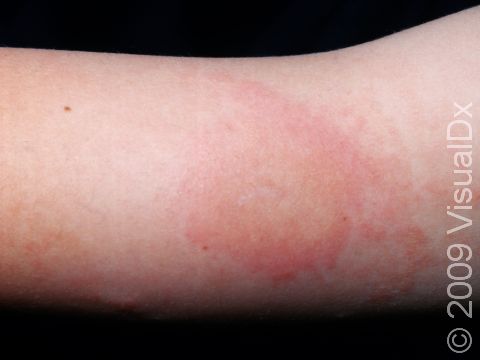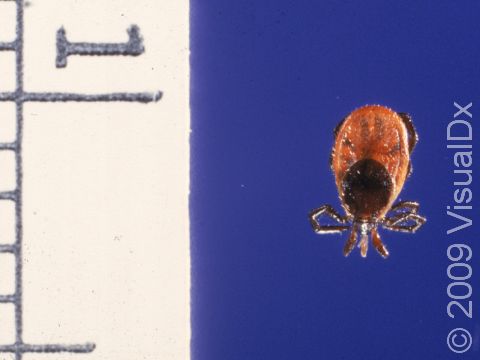Lyme Disease
Lyme disease is the result of infection with the bacteria Borrelia burgdorferi. The disease is transmitted by infected ticks that also feed on mice and deer. The tick can be found attached to the skin in many cases. Most cases of Lyme disease occur in the spring and summer months.
Lyme disease, in most cases, can be eliminated with antibiotics, especially if treatment is started when symptoms are first noted.
Lyme disease is divided into 3 phases:
Early localized:
Symptoms start a few days to a month after a tick bite. The classic “bull’s eye” lesion does not need to develop for a diagnosis of Lyme disease. If left untreated, the disease can spread to the lymph nodes.
Early disseminated:
Multiple skin lesions are seen, along with flu-like symptoms and head, neck, and joint pain. There may also be heart or nerve symptoms as well as arthritis, which can develop over a few months to up to 2 years after the initial infection.
Late:
The heart, joints, and nervous system can be affected. Symptom can develop over a few months to years after the initial infection and may be difficult to treat.
Who's At Risk?
Lyme disease is transmitted by infected ticks and cannot be “caught” from an infected person or passed from one sibling to another. Children who spend a lot of time in or near wooded areas are at a higher risk for contracting Lyme disease. Lyme disease is reported most often in the Northeastern US from Maine to Maryland, in the Midwest in Minnesota and Wisconsin, and in the West in Oregon and Northern California. It has also been reported in China, Europe, Japan, Australia, and the parts of the former Soviet Union.
Signs & Symptoms
Sometimes the tick can be found attached to the skin. Bite marks may not necessarily be visible.
Erythema migrans, the classic unraised red “bull’s-eye” lesion on the skin, will appear days to weeks after the bite. However, about 25% of those affected never get this lesion. Some may complain of flu-like symptoms, including fever; head, neck, and joint pain; and generalized muscle pain. The lesion will resolve without treatment in about a month.
Weeks to months later the bacterium can affect the joints, heart, and nervous system.
The late phase of Lyme disease can also affect the joints, heart, and nervous system. In the heart, there can be an abnormal heart rhythm. The face can become paralyzed (facial muscle paralysis), and you can have confusion and abnormal sensations of the skin such as numbness, tingling, a prickling sensation, or pain. There can be inflammation in the joints, or arthritis, beginning with swelling, stiffness, and pain, commonly affecting the knees.
Self-Care Guidelines
If you think your child has Lyme disease, call his or her doctor. If you have found a tick on the skin and removed it, save it in a jar of alcohol for identification.
Ticks begin transmitting Lyme disease about 24–48 hours after attaching to the host. You can reduce your child’s chances of getting Lyme disease by removing the tick within 48 hours.
To remove the tick, you will need tweezers and isopropyl alcohol. Your child may be scared, but you should explain that this will not hurt them.
- Sterilize the tweezers with alcohol and make sure to wash your hands. You should not clean or disturb the skin with the tick.
- Grasp the part of the tick that is embedded in the skin with the tweezers, not the body where you may see tiny legs. If necessary, have someone else hold the area with the tick so that the child doesn’t jerk away.
- The tick will likely be firmly embedded. Pull it outward in one motion. Do not twist or jerk the tweezers. Do not apply anything to the tick that you think may help it come out smoothly as this may result in a part of the tick being left in the skin.
- Clean the bite wound with alcohol. Children have very sensitive skin, so you may notice an immediate swelling where the once was. If you are not sure that the entire tick has been removed, see your child’s doctor.
Observe the bitten area for the appearance of a rash for up to a month after the bite. It is probably best to call your child’s doctor for further guidance if you think he or she has been bitten by a tick. If a rash or other early symptoms of Lyme disease develop, see a physician immediately.
Treatments
Lyme disease can be treated and cured with one of several oral antibiotics for 3–4 weeks. The skin rash will go away within a few days of beginning treatment, but other symptoms may persist for up to a few weeks. In severe cases of Lyme disease where the nervous system is involved, the antibiotic may need to be given intravenously. In late stage Lyme disease, symptoms may not go away completely but should improve.
Visit Urgency
It is probably best to call your child’s doctor for further guidance if you think they have been bitten by a tick. If a rash or other early symptoms of Lyme disease develop, see a physician immediately.
References
Bolognia, Jean L., ed. Dermatology, pp. 1138-1139. New York: Mosby, 2003.
Wolff, Klaus, ed. Fitzpatrick’s Dermatology in General Medicine. 7th ed., pp. 1797-1806. New York: McGraw-Hill, 2008.
Last modified on August 16th, 2022 at 2:45 pm

Not sure what to look for?
Try our new Rash and Skin Condition Finder



